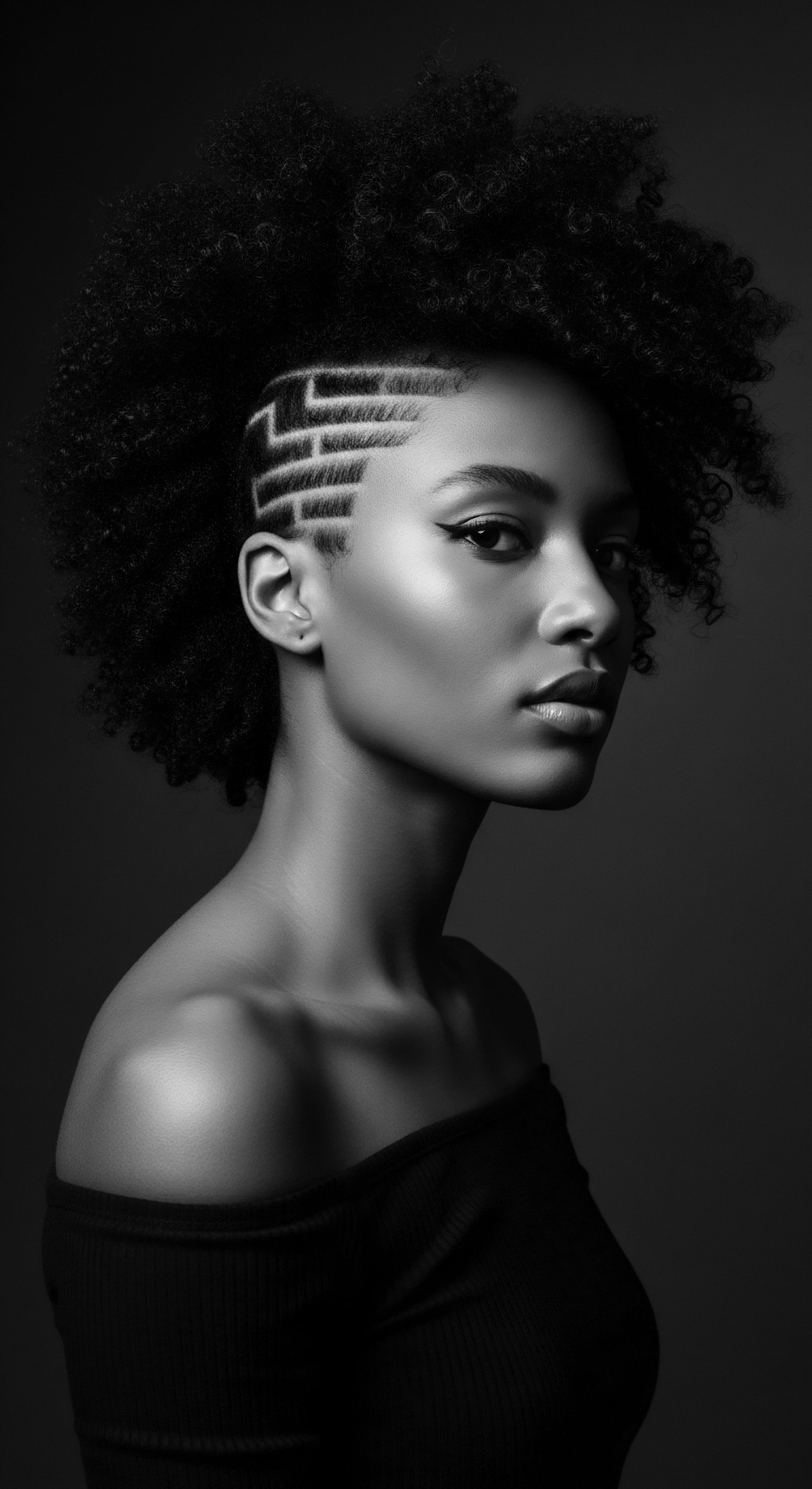
Fundamentals
The exploration of what we might call ‘Fractal Hair’ begins not in complex laboratories or scholarly texts, but in the elemental observation of the world around us. Consider the delicate unfurling of a fern frond, or the branching pathways of a river system as it seeks the sea; these natural formations reveal repeating patterns across varied scales. Our textured hair, a marvel of natural design, carries similar echoes of this universal design principle. It is an inherent geometric complexity, a self-repeating pattern woven into the very fabric of curls, coils, and waves, extending from the visible curl pattern to the very micro-architecture of each strand.
This initial understanding, a simple recognition, suggests a deeper truth about hair. The term ‘Fractal Hair’ describes the presence of these intricate, multi-scalar designs. It is the acknowledgement that the grand sweep of a tightly coiled cascade shares an underlying structural logic with the minute twists and turns of an individual fiber.
This concept is not merely a theoretical construct; it grounds our appreciation for the intrinsic complexity and inherent resilience of textured hair. It reminds us that beauty resides not in uniformity, but in the sophisticated, naturally occurring order found within diverse hair patterns.
Fractal Hair signifies the inherent, multi-scalar geometric complexity found in textured hair, mirroring repeating natural patterns from visible curl formations to microscopic strand structures.
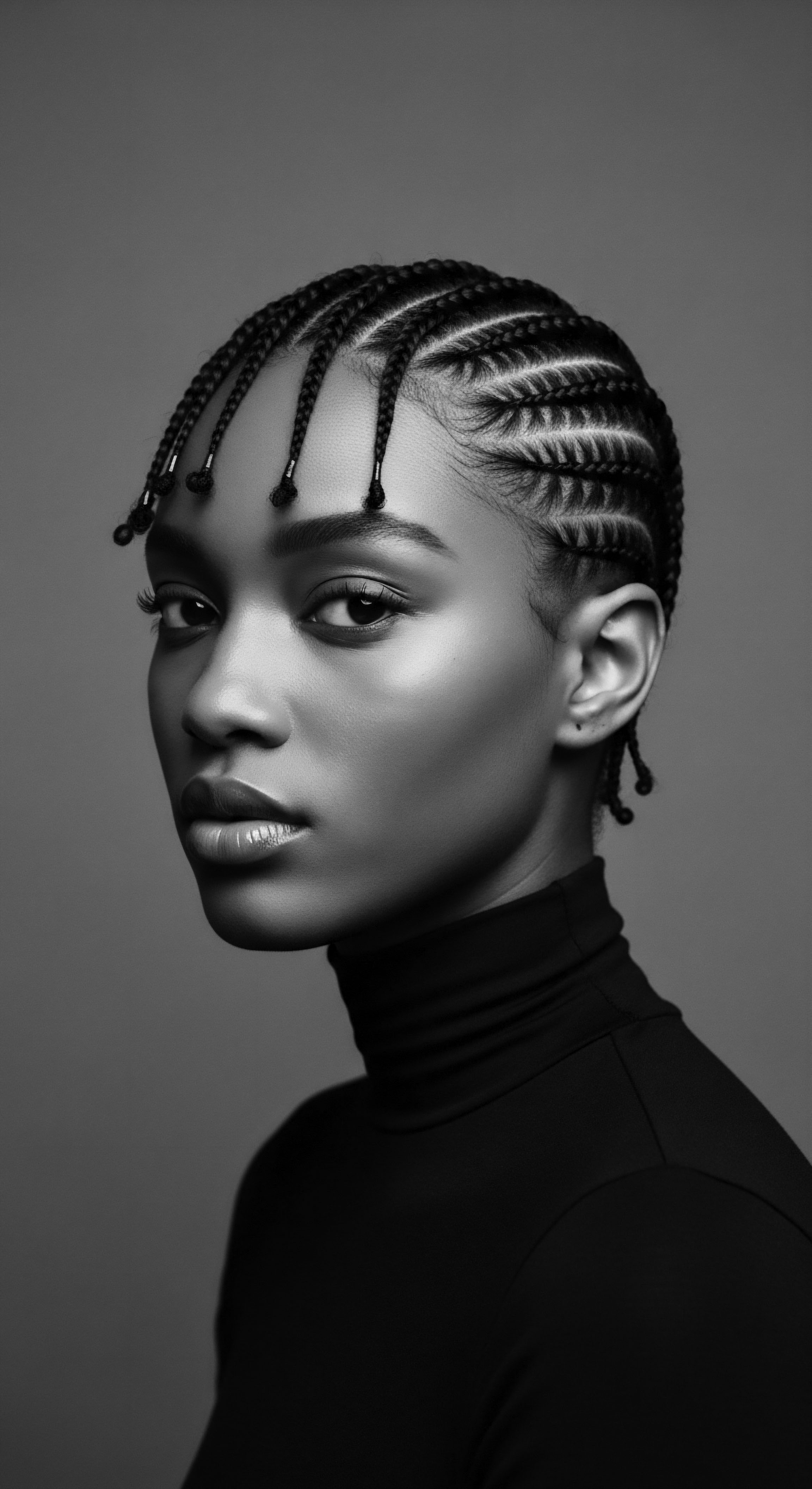
The Visual Signature of Complexity
To discern the essence of Fractal Hair, we first observe its visual manifestation. Look closely at a tightly coiled strand. What appears as a singular, undulating form is, upon closer inspection, a series of smaller coils nested within larger ones, each loop creating a distinct, yet connected, geometry.
This tiered arrangement, where parts resemble the whole, is a hallmark of fractal principles. The way light plays across these curves, the manner in which moisture collects and distributes along their intricate pathways, each speaks to a design that prioritizes complexity over simplistic linear form.
This visual signature is significant for its cultural resonance. Throughout history, communities with textured hair have intuitively understood and celebrated this natural complexity. From the intricate braiding patterns of ancient African civilizations to the nuanced care rituals passed down through generations, the styling of hair has often mirrored its inherent fractal qualities.
These practices did not merely aim to tame; they sought to harmonize with the hair’s natural inclinations, recognizing its volume, its resilience, and its capacity to hold form in ways straight hair cannot. This foundational insight, gleaned from generations of lived experience, formed the earliest understanding of what we now conceptually term Fractal Hair.
- Coil Definition ❉ The distinct, spring-like formations present in highly textured hair, exhibiting consistent and repeating patterns.
- Wave Amplitude ❉ The measure of the height or depth of a wave pattern in hair, often demonstrating variability that contributes to fractal qualities.
- Curl Clusters ❉ Groups of individual strands that naturally bind together, forming larger, coherent curl formations.

Intermediate
Moving beyond simple observation, an intermediate understanding of Fractal Hair delves into the intrinsic properties that underpin its unique characteristics. This is where the biological architecture of textured hair begins to reveal its secrets, showcasing how the macroscopic patterns we cherish are reflections of sophisticated structural designs at the cellular and molecular levels. The very shape of the hair follicle itself, along with the asymmetrical distribution of keratin proteins within the hair shaft, contribute to the characteristic curves, coils, and waves that define textured hair.
The shape of the hair strand, often elliptical or flattened in cross-section rather than perfectly round, dictates the direction and tightness of its curl. As this non-uniform strand grows from an elliptically shaped follicle, it begins to twist and turn upon itself, creating a helical pathway. This inherent torsion, a natural predisposition to coil, results in repeating geometric forms.
Each coil, however small, holds the potential for further coiling, reflecting patterns within patterns. This is the structural meaning of Fractal Hair ❉ the interplay between intrinsic cellular design and emergent physical shape.
The intrinsic design of textured hair, from follicular shape to protein distribution, manifests repeating geometric forms, unveiling the deeper structural meaning of Fractal Hair.

Biological Foundations of Form
The biological underpinning of Fractal Hair speaks to a wondrous ingenuity of nature. Consider the distribution of Keratin, the primary protein composing hair. In straight hair, keratin is typically distributed more evenly within the cortex. In textured hair, however, the arrangement of keratin, particularly the softer Orthocortex and denser Paracortex, can be asymmetrical.
This uneven distribution contributes to differing rates of contraction and expansion along the hair shaft, compelling it to curve and coil. This microscopic asymmetry creates a macroscopic spiral, and within that spiral, further intricate turns emerge.
Furthermore, the orientation of the hair follicles on the scalp is rarely perfectly perpendicular for textured hair. Often, follicles emerge at an angle, directing the initial growth path in a curve. This initial deviation from a straight path sets the stage for the helical growth pattern that follows.
It is this fundamental biological predisposition, a genetic inheritance that shapes the very architecture of our hair, that truly distinguishes Fractal Hair as a concept. Understanding this biological blueprint allows for a more attuned approach to hair care, one that honors its natural tendencies rather than seeking to impose a foreign linearity upon it.
| Traditional Practice Oiling and Sealing |
| Implicit Understanding of Fractal Hair Recognized the need to lubricate intricate coil patterns to prevent friction and enhance shine, acknowledging the complex surface area. |
| Traditional Practice Protective Styling (Braids, Twists) |
| Implicit Understanding of Fractal Hair Utilized the hair's capacity to interlock and hold form, preserving intricate patterns and reducing external stress on fragile curves. |
| Traditional Practice Finger Coiling/Shingling |
| Implicit Understanding of Fractal Hair Enhanced and defined the natural, repeating curl patterns, working with the hair's inherent desire to coil and clump. |
| Traditional Practice Ancestral methods often intuitively interacted with the fractal qualities of hair, promoting its resilience and honoring its intrinsic forms. |
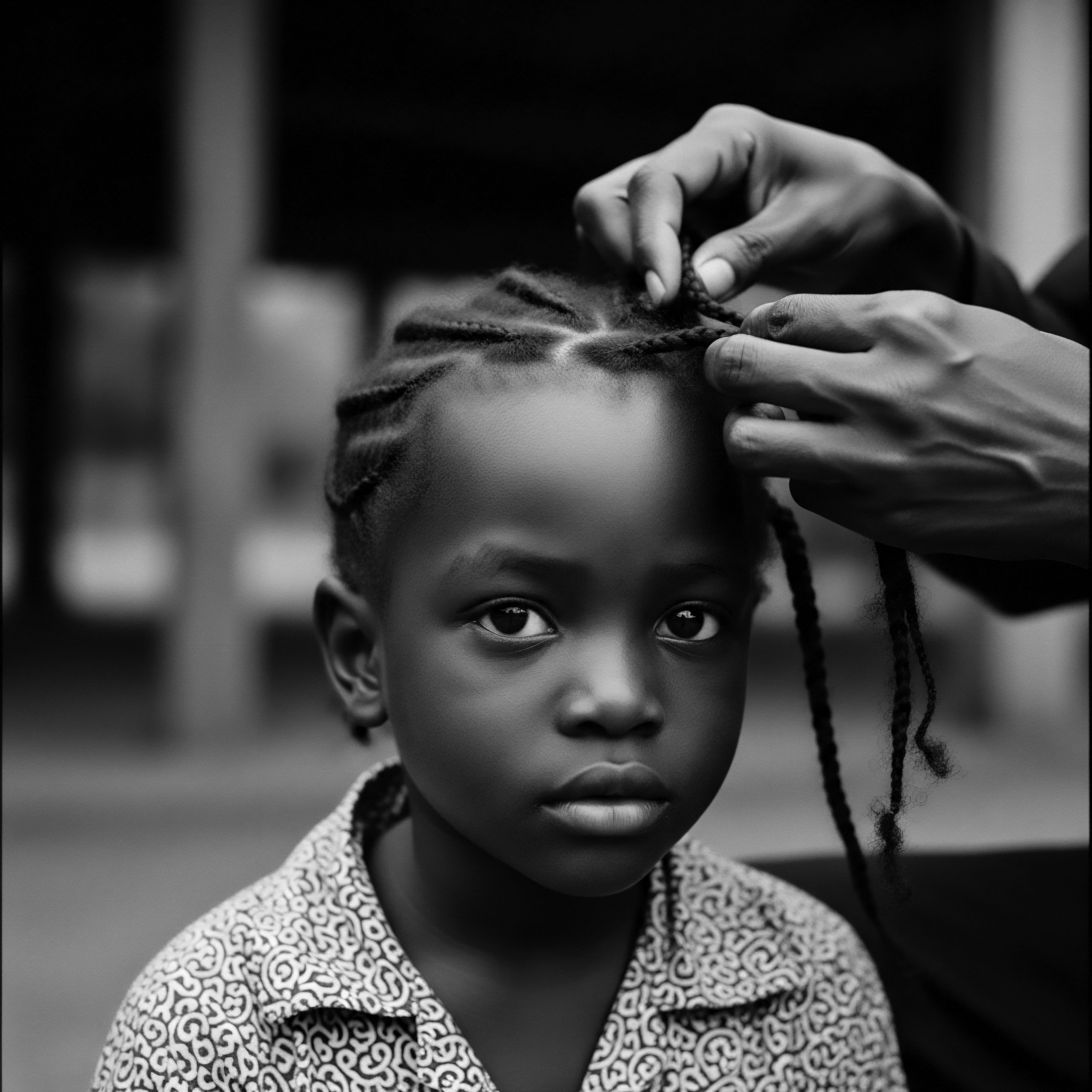
Cultural Relevance and Ancestral Wisdom
The concept of Fractal Hair is not solely a scientific curiosity; it carries significant cultural weight. Ancestral hair practices, passed down through generations, often display an intuitive understanding of these very principles. Consider the meticulous artistry of traditional Cornrowing, where hair is braided closely to the scalp in linear or curvilinear patterns, yet the individual strands within each braid maintain their inherent coil or wave.
This creates a larger, organized pattern from smaller, natural textures. This kind of styling required a profound sensitivity to the hair’s natural leanings, its ability to hold form, and its tendency to cluster in specific ways.
These practices were not merely cosmetic. They served as vital forms of cultural expression, identity markers, and even practical tools for survival. The intricate, often multi-layered patterns of traditional African hairstyles, many of which can be seen as macroscopic fractals, communicated tribal affiliation, marital status, age, and social standing. The very act of styling became a communal ritual, a moment of connection and knowledge transfer, where the understanding of hair’s true nature – its strength in complexity, its beauty in its unique twists – was implicitly shared and reinforced.
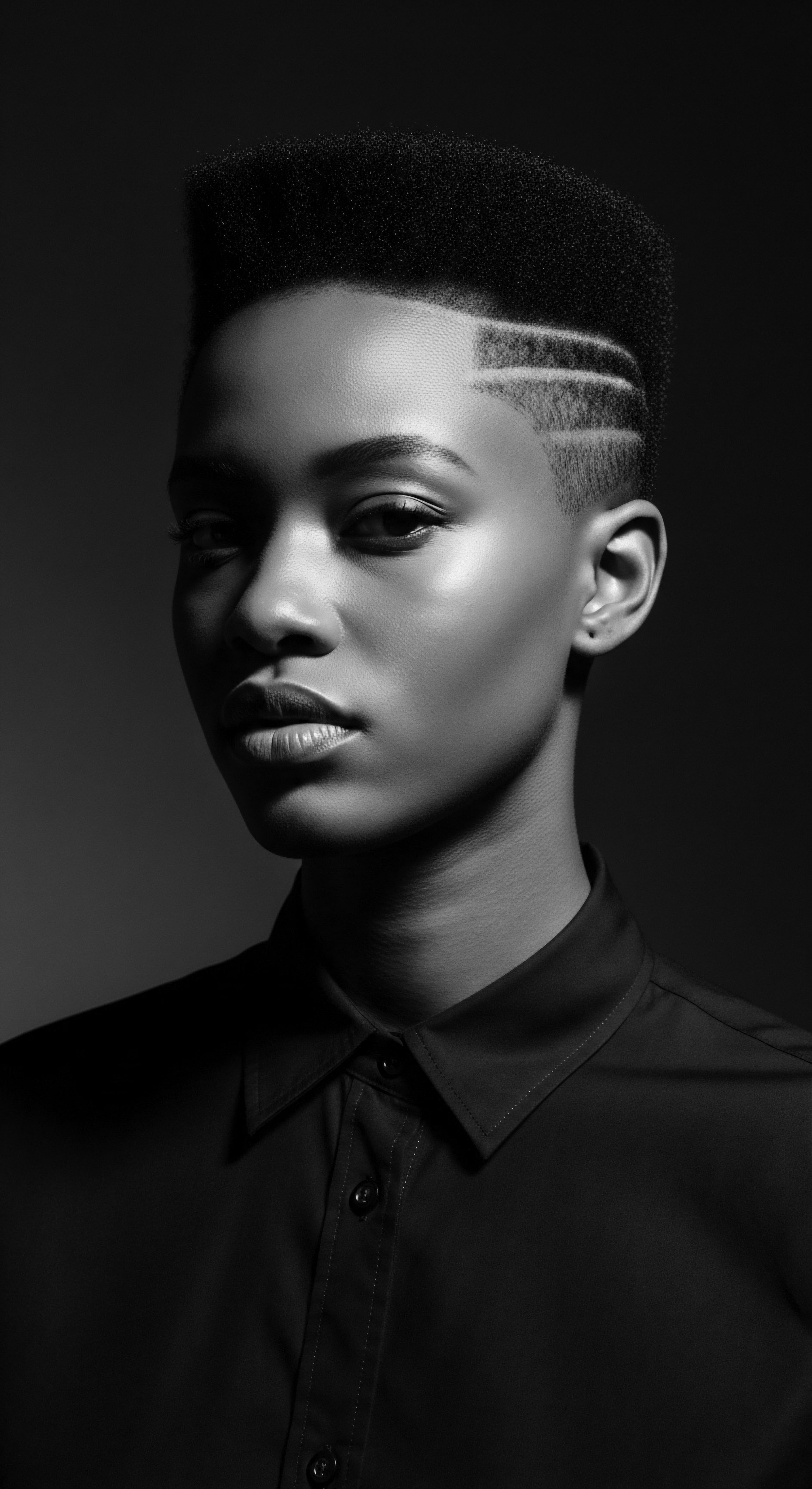
Academic
The definitive academic interpretation of Fractal Hair posits it as a framework for comprehending the profound structural and aesthetic characteristics of textured hair through the lens of non-Euclidean geometry and biophysics. This goes beyond superficial observation, delving into the underlying mathematical principles that govern the formation of coils, kinks, and waves across multiple orders of magnitude. The meaning here is rooted in the recognition that textured hair shafts do not conform to simple, singular geometric descriptions; rather, they exhibit characteristics consistent with fractal dimensions, where self-similarity and recursive patterning are inherent to their very existence. This concept applies from the macro-scale of a complete curl pattern to the micro-scale of cuticle layering and even the internal protein arrangements within the cortex.
This sophisticated viewpoint considers the hair follicle’s elliptical or highly asymmetrical cross-section as the foundational determinant of macroscopic curl. As the hair fiber emerges, the differential growth rates and protein synthesis along its perimeter, coupled with the angularity of the follicle, compel the strand to twist and coil. This twisting introduces torsion, and the cumulative effect of these microscopic torsions generates complex helical structures. The concept of a fractal dimension here extends to how stress and strain are distributed along these intricate curves.
Unlike straight hair, where stress is concentrated at points of bending, the inherent curves of textured hair allow for a more even distribution of force, contributing to its remarkable elasticity and resistance to breakage when properly cared for. This often overlooked aspect of its structural integrity is a testament to its evolutionary brilliance.

Morphological Determinants and Biophysical Insights
The morphology of textured hair presents a rich subject for biophysical inquiry, revealing the intricate dance between genetics and structural mechanics that define Fractal Hair. Researchers have examined the correlation between the shape of the hair follicle and the resulting curl pattern, noting that increasingly flattened or kidney-bean-shaped follicles produce tighter coils. Furthermore, the differential expression and arrangement of keratin-associated proteins within the hair cortex contribute significantly to the hair’s inherent curvature. The orthocortex and paracortex, distinct regions of the hair cortex, possess differing mechanical properties.
The preferential distribution of these regions within an asymmetrical hair shaft causes it to curl, as one side contracts or expands differently from the other. This differential tension, iterated along the length of the strand, creates a continuous, self-organizing pattern that mirrors fractal principles.
Scientific investigations have explored how this complex architecture impacts the mechanical properties of textured hair. While individual textured strands might appear more fragile due to their numerous bends and twists, the collective behavior of these strands, when grouped, can demonstrate surprising resilience. The inherent elasticity of coiled hair allows it to stretch and return to its original form, absorbing mechanical stress more effectively than a straight strand.
This property, often misconstrued as weakness, is a critical adaptation for volumetric styling and for protecting the scalp. Studies applying continuum mechanics to hair fibers have modeled these complex stress distributions, showing how the unique geometry of textured hair optimizes its performance under tension.

Historical Context and the Intricacy of Ancestral Practices
The profound meaning of Fractal Hair is perhaps most vividly illustrated through its deep interconnectedness with ancestral human practices, particularly within communities of African descent. Long before the advent of modern microscopy or biophysical modeling, these communities possessed an intuitive, embodied understanding of hair’s complex nature. This understanding wasn’t codified in scientific journals but lived in the hands that braided, twisted, and styled hair for millennia. Consider the extraordinary historical example of hair as a repository during moments of forced migration and cultural preservation, specifically during the transatlantic slave trade.
The tight, dense coiling patterns of textured hair, which epitomize fractal geometry in their capacity to hold and conceal, became an ingenious, clandestine storage system. Enslaved Africans, facing unimaginable cruelty and uncertainty, braided seeds—grains like rice, millet, and other vital sustenance—into their elaborate hairstyles before being forcibly transported across oceans. This practice was not merely an act of defiance; it was a testament to the hair’s inherent capacity to serve as a functional carrier, its intricate structure offering concealment and security for precious cargo vital for survival and the re-establishment of culture in foreign lands. As documented by historians like A.
D. Byrd and L. D. Tharps in their work, Hair Story ❉ Untangling the Roots of Black Hair in America, this profound act of resistance leveraged the very physical attributes of textured hair that we now conceptualize as fractal.
They state, “These intricate styles were not only aesthetically pleasing but served vital social and practical functions, sometimes even hiding seeds for new crops or gold dust for survival” (Byrd & Tharps, 2001). This deeply contextualizes the concept of Fractal Hair, not as a theoretical abstraction, but as a lived reality with tangible consequences for human survival and cultural continuity.
Ancestral communities intuitively understood the fractal nature of hair, using its intricate patterns to store seeds and precious items during dire historical moments, underscoring its functional significance beyond aesthetics.
This historical instance highlights the extraordinary interplay between hair’s intrinsic structural properties and human ingenuity in the face of adversity. The very density and capacity for interwoven complexity within textured hair, hallmarks of its fractal nature, provided a means of preserving not just life-sustaining resources but also a symbolic link to ancestral lands and traditions. This deeply embedded knowledge, passed through generations, informed centuries of care practices that recognized and worked with the hair’s natural contours and strengths. The techniques of twisting, coiling, and braiding, often done with natural oils and herbs, served to maintain the hair’s structural integrity, allowing it to fulfill its multifaceted roles, whether as a medium for artistic expression, a marker of identity, or a hidden vessel of hope.
- Follicle Angulation ❉ The angle at which the hair follicle emerges from the scalp, a primary determinant of curl initiation and direction.
- Keratin Asymmetry ❉ The uneven distribution of keratin types (ortho- and paracortex) within the hair shaft, causing differential tension and curvature.
- Stress Distribution ❉ The unique manner in which mechanical forces are dissipated along the curves and coils of textured hair, contributing to its resilience.
- Hydration Dynamics ❉ How moisture interacts with and is retained by the complex, fractal-like surface area of coiled hair, impacting its health and elasticity.

Interconnected Incidences Across Fields
The academic investigation of Fractal Hair extends into interdisciplinary domains, revealing its interconnectedness with fields beyond pure biophysics. In cultural anthropology, the recurring motifs in traditional African art, textiles, and architecture often mirror the complex, repeating geometric patterns found in textured hair. This suggests a deep, underlying aesthetic sensibility that perceives beauty and order in self-similar complexity. The intricate knot-work in ancient West African art, for instance, evokes the layered patterns of tightly braided hair, indicating a shared understanding of form and repetition.
From a psychological perspective, the reclamation and celebration of natural textured hair, often a manifestation of its fractal beauty, represent profound acts of identity affirmation and self-acceptance. In post-colonial contexts, where Eurocentric beauty standards often devalued textured hair, the intentional choice to wear natural styles is a powerful reclaiming of ancestral heritage. This choice is supported by a growing body of psychological literature on identity formation and self-esteem within diasporic communities.
Understanding the fractal nature of one’s hair can contribute to a deeper appreciation for its inherent beauty and resilience, fostering a positive body image and a stronger connection to one’s lineage. The cultural meaning of Fractal Hair transcends its biological definition, transforming into a symbol of pride, history, and continuity.

Reflection on the Heritage of Fractal Hair
The conceptual journey through Fractal Hair is more than an academic exercise; it is an invitation to witness and revere the enduring lineage woven into every coil, every wave, every nuanced curve of textured hair. We find within its very structure an echo of ancient wisdom, a testament to resilience, and a living, breathing archive of human heritage. The intricate patterns, the robust elasticity, the inherent capacity to hold and express—these are not accidental attributes. They are the cumulative gifts of generations, shaped by environments, sustained by ancestral hands, and celebrated through diverse cultural narratives that span continents and centuries.
From the quiet moments of ancestral care, where hands passed down techniques of oiling and braiding that intuitively respected the hair’s complex geometry, to the modern scientist unraveling the biophysical secrets of its strength, a continuous thread of appreciation unfolds. This thread reminds us that the beauty of textured hair is not a fleeting trend, but a timeless expression of nature’s genius and human adaptability. It stands as a beacon, guiding us back to a holistic understanding where science and spirit, history and innovation, converge in the celebration of hair’s profound role in voicing identity and shaping futures. The true significance of Fractal Hair, then, lies in its capacity to connect us not just to a deeper scientific understanding, but to the soulful narrative of who we are and from whom we came.
The enduring heritage of Fractal Hair connects us to ancestral wisdom, celebrating its intricate beauty as a living testament to resilience and a profound expression of identity.
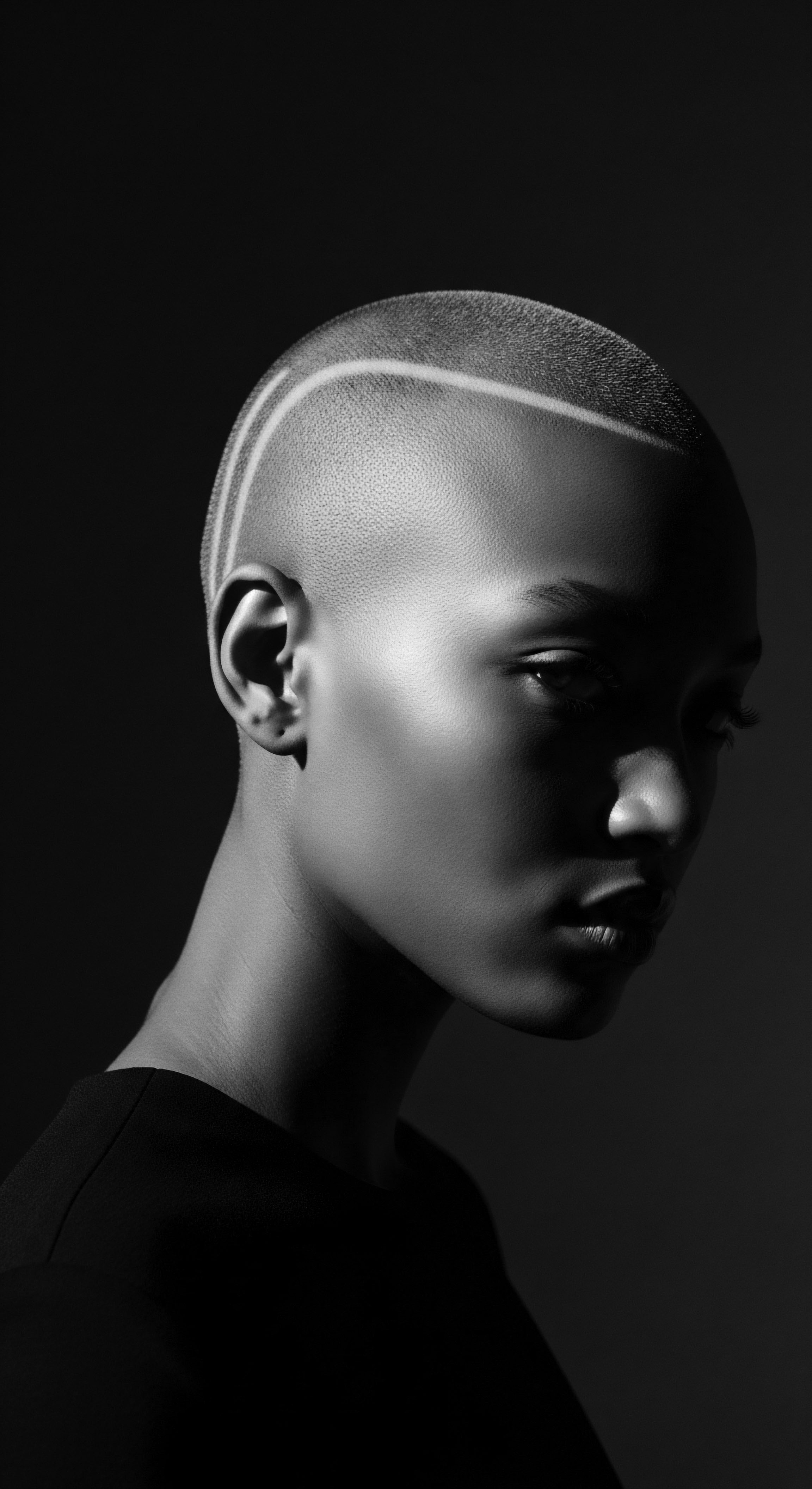
References
- Byrd, A. D. & Tharps, L. D. (2001). Hair Story ❉ Untangling the Roots of Black Hair in America. St. Martin’s Press.
- Robbins, C. R. (2012). Chemical and Physical Behavior of Human Hair (5th ed.). Springer.
- De la Mettrie, J. O. (1748). Man a Machine. (Many editions available; reference to early anatomical observations of hair).
- Gavrilov, D. & Popov, K. (2018). Mathematical Modeling of Hair Structure and Growth. Nova Science Publishers.
- Mercer, K. (1994). Welcome to the Jungle ❉ New Positions in Black Cultural Studies. Routledge. (Contains analyses of hair in cultural identity).
- Porter, N. (2016). Hair Care ❉ An Illustrated Dermatological Handbook. CRC Press.
- Tressler, J. L. (2018). The Geometry of Biological Forms. Academic Press. (Contextualizes fractal patterns in biological systems).
